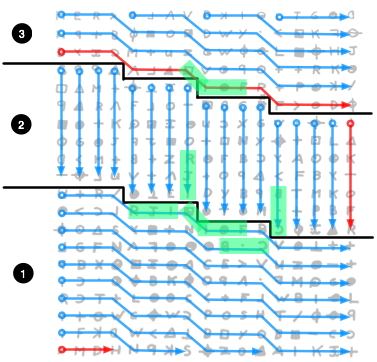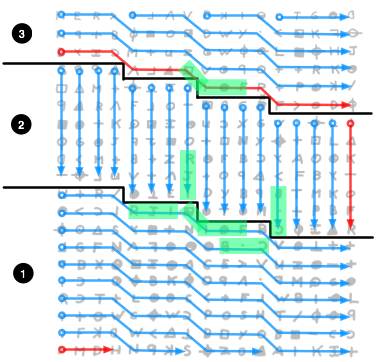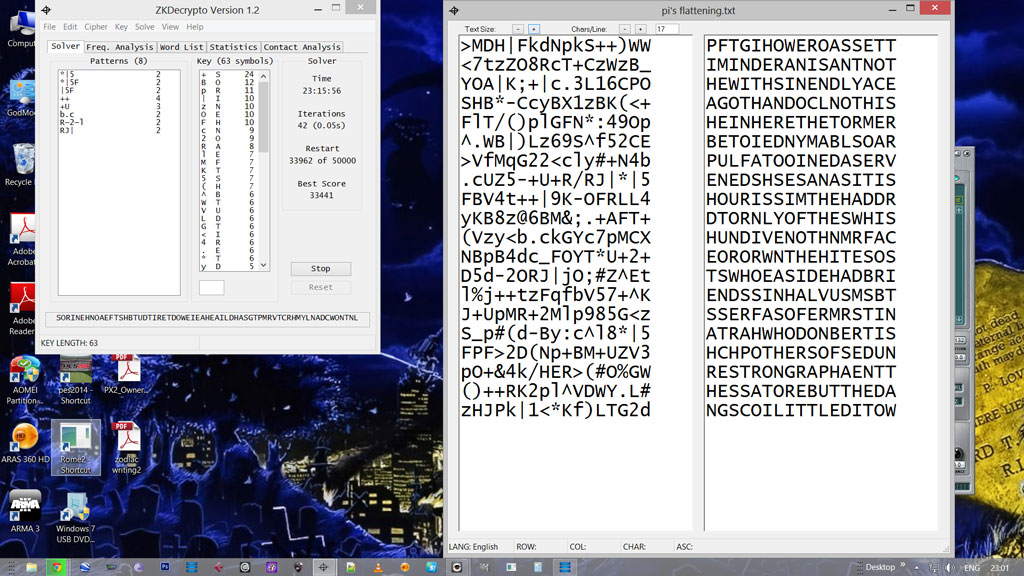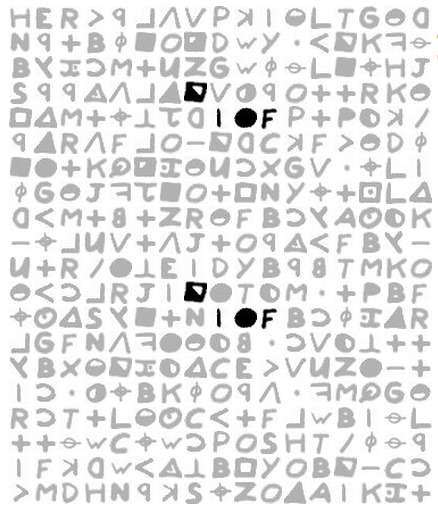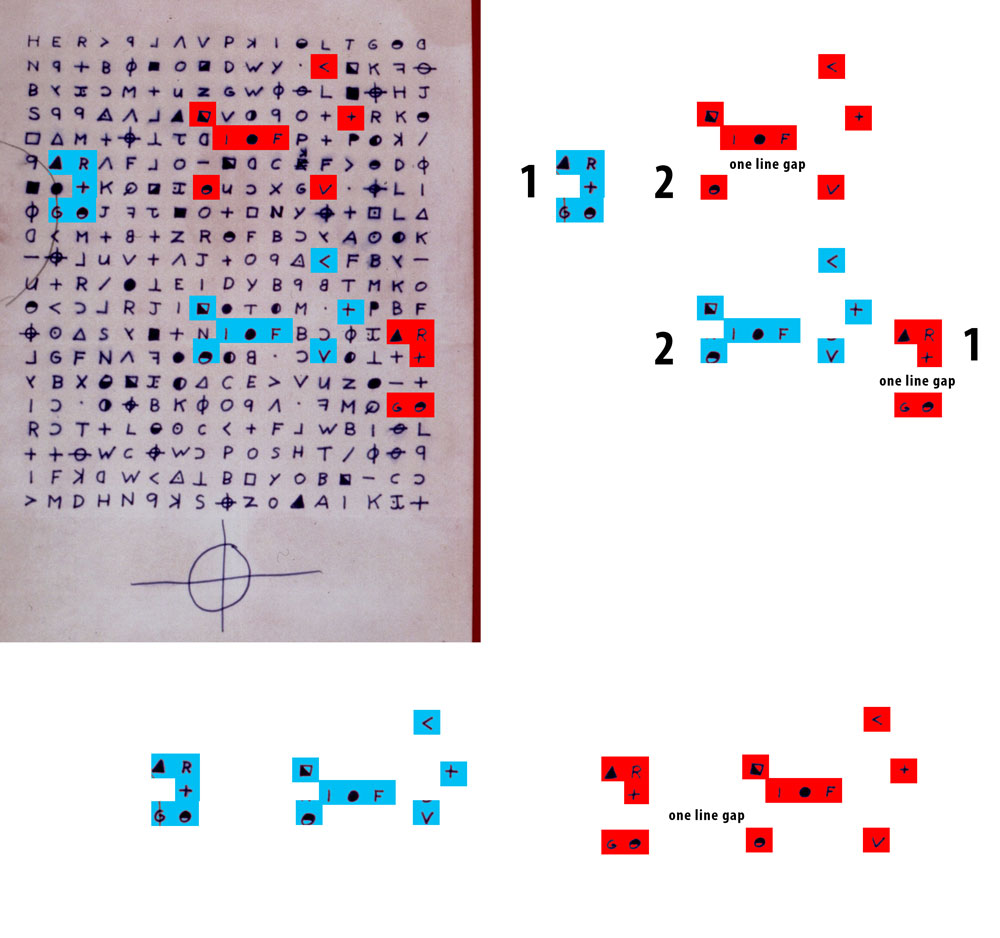If that’s the strongest homophone, is it "E", and is the "next weakest" then a "T" and so on? Or variations thereof?
No of course not. Don’t mind me, I haven’t had a coffee yet.
No – I don’t think there’s any guarantee that it would be a particular letter, since the cycles are designed to hide letter frequencies.
If you order the 3-symbol cycles in the 408 by strength, it goes "I", "N", "E", "T", etc.
Also, the strength I’m referring to is a numerical estimate of the difficulty in producing the sequence by chance. For example, the 

 sequence in the 408 has more than a billion to one odds against it occurring by random chance. But the
sequence in the 408 has more than a billion to one odds against it occurring by random chance. But the 

 sequence in the 340 has about 400,000 to one odds against it occurring by random chance.
sequence in the 340 has about 400,000 to one odds against it occurring by random chance.
D., no of course there aren’t any guarantees which is why I tweaked you a bit and made my terrific joke – yes, that’s what suppression’s for – but my underlying question remains – pre-coffee, at least. I know the 408’s plain-text order doesn’t match normal distribution very well – nothing 390 characters long is ever likely to (he said, philosophically) – but if you, for instance, order the 408 symbols "by strength" with your marvellous statistical analysis, then apply ETOAIN can you "read" it? It ain’t coincidence that four of the most common characters are vowels, after all.
I’m wondering how far "off" it is, I suppose. And how far off any collection is and has to be, before plain stats don’t help.
Make any sense?
Naaaa, forget it. If I go change things out in the 408 solve in your toy or in zkd one at a time, I can get the answer pretty darn rapidly can’t I…..
And I know what it’s going to be…..
Oops!
Right, time for a coffee.
Here is a way to read the z340 in order to flatten the two 3-character pivots and the "square-IOF" pattern:
The diagram breaks down the z340 in 3 bands or routes. The arrows indicate the reading order. The reading starts, in each band, from the red arrow. The pivots and patterns are highlighted in green.
Using these routes, 2 repeating trigraphs and 1 repeating tetragraph are created from the original pivots and patterns. However, this destroys the original "FBc" trigraph.
Very interesting work, pi. I wonder what will happen when we feed the various permutations of that into zkdecrypto.
Great work pi. I was pondering something similar but thank god you tackled it.
Yes, next stop decrypto. I wish there was piece of software with a function like OCR for ciphers to turn them into ascii.
By popular demand:
>MDH|FkdNpkS++)WW <7tzZO8RcT+CzWzB_ YOA|K;+|c.3L16CPO SHB*-CcyBX1zBK(<+ FlT/()plGFN*:49Op ^.WB|)Lz69S^f52CE >VfMqG22<cly#+N4b .cUZ5-+U+R/RJ|*|5 FBV4t++|9K-OFRLL4 yKB8z@6BM&;.+AFT+ (Vzy<b.ckGYc7pMCX NBpB4dc_FOYT*U+2+ D5d-2ORJ|jO;#Z^Et l%j++tzFqfbV57+^K J+UpMR+2Mlp985G<z S_p#(d-By:c^l8*|5 FPF>2D(Np+BM+UZV3 pO+&4k/HER>(#O%GW ()++RK2pl^VDWY.L# zHJPk|1<*Kf)LTG2d
ZKD does not seem too impressed. Let me know if you find anything of interest in here.
Obviously, there are many other possible ways to flatten the pivots. What a strange sentence…
Yeah nothing other than ‘BUTTHEDA’ near the bottom lol. There’s other partial things there but it’s the same as every other try basically, nothing significantly new or different unfortunately and as usual, open to inconclusive interpretation. This is at 23hrs.
Using the "alignment analysis" tool in Cryptoscope, you can find other similar repeated patterns whose symbols are tightly clustered. Examples:
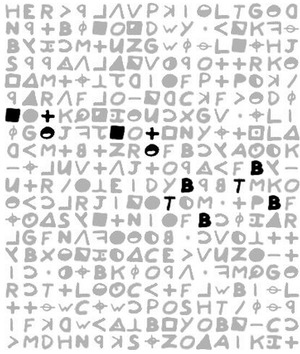
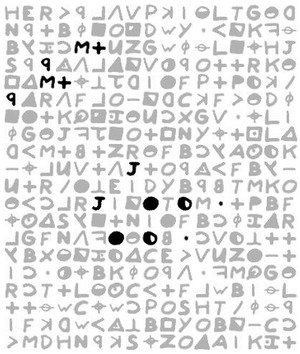
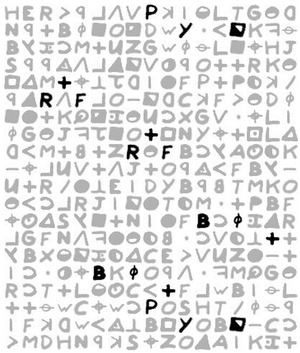
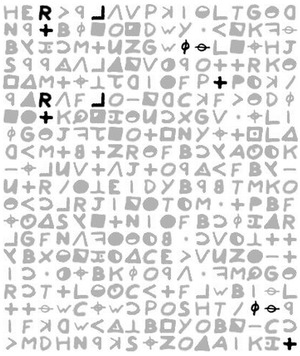
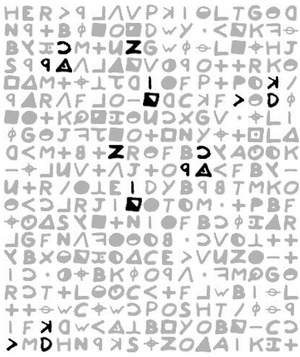
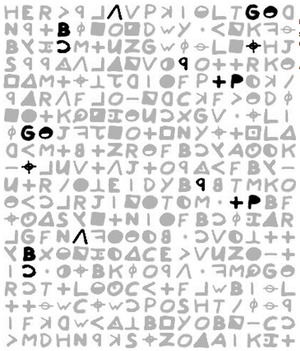
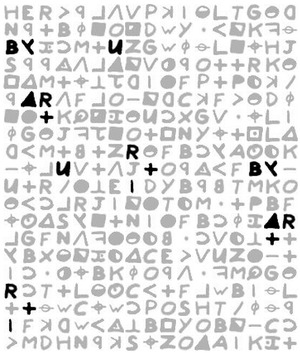
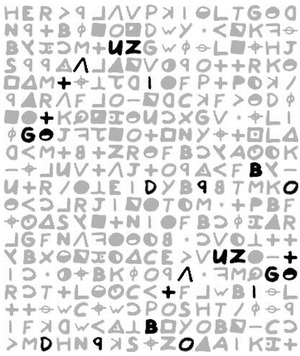
Similar patterns can be found in the 408, and I think are happening due to the number of ways symbols are allowed to repeat. Or, to put it another way, the number of possible formations of repeated symbols is much larger than when simply reading from left to right, resulting in many more opportunities for repeats to happen.
Here’s the ascii for the 2 diagonal grids. I’m running the first one now (grid 1 followed by grid 2 combined) same old bunch o’ nothin’. I’m posting these here separated so if anyone wants to they can combine them in what ever configuration. I’m going to try one above the other next, not expecting anything.
H R Ð ^ P I L G Ä
Ð B · º W • » Æ
B „ M u G ¢ L ¤ J
Ð ½ Ì » ´ O + K
¸ M ¤ Ê I F + ³ /
¾ ^ Ì – Ä Ë > D
· + Ñ ƒ u X V ¤ I
G J Ê O ¸ y + L
Ä M Â Z ± B Ÿ ° K
¤ u + J O ½ F Ÿ
u R µ E D B Â M O
< Ì J » T M + B
¤ ¼ Ÿ + I F Ã ƒ R
G N Æ ± Â Ã ³ +
Ÿ X » ³ C > u µ +
à ´ B ¢ Ð • M G
R T L ° < F W I L
+ W ¤ Ã O H / £
I Ë W ½ B y B – Ã
M H Ð S Z ¾ I ƒ
E > Ì V Ë ² T ±
N + ¢ O D y < K £
Ÿ Ã + Z W £ · H
S Ð ^ ¾ V Ð + R ±
¼ + Ô Ä µ P ˆ Ë
Ð R F O » C F ± ¢
µ K º ± Ã G • L
¢ ± Æ · + N ¤ ¹ ¼
< + + R F Ã A ³
– Ì V ^ + Ð < B –
+ / Ô I y Ð T K
± Ã R I µ ³ • ˆ F
° S · N µ B ¢ ¾
Ì F ^ µ ³ • V Ô +
B ² „ ¼ E V Z –
I • ¤ K O ^ Æ Ñ ±
à + ² C + Ì B £
+ £ C W P S T ¢ Ð
F Ä < Ô ¸ O » C
> D N Ë ¤ O A K +
Another pattern intersects with the other pivot, too:
I couldn’t decide where to post this. My eyes are too tired to keep trying so I’m tagging it on the back of this IOF post by dave.
Yup, patterns. I’m at it again. It’s like a de-stresser after looking at handwriting. I thought I would have ‘stare’ at the thing and I was starting with the simple horizontal and vertical bi-grams. You know the R+ and M+ etc. Just wanted to highlight them and do more staring. Then I spotted something and started again. I noticed a repeat pattern off one of the vertical R+ arrangements. Just an extra symbol, the filled in triangle. Then I spotted the G and the bottom half filled circle was also repeated below it. The difference being that in the second occurrence these two symbols were on line lower.
Just more ‘normal’ but ‘unusual’ cipher behavior. I thought I would work out from it and just see if there was anything else. There was.
If encompassed the IOF wotsit with the diagonal filled square as shown in dave’s repeated pattern post. So Including it I kept going. This is when the ‘gap’ thing became apparent/incorporated. It expanded to include a top filled circle, left arrow, down arrow and a +. So basically what I ended up with was …..how to word this lol … a two part pattern where the first pattern (IN BLUE) reads from left to right – the second pattern (IN RED) is reversed, reads from right to left and includes a ‘one line gap’ on the last line in both of it’s parts.
God help us.
Does it mean anything? probably not but if nothing else I’ll be in the running for ‘most convuluted pattern’. ![]()
Anywho, here’s a diagram.
trav – even if the pattern isn’t indicative of the scheme used, it certainly lends credence to the belief that there is some kind of internal consistency as work (versus being a random wild goose chase).
Hey traveller1st,
Great find. And whatever it is I’m really glad you found it! It would be a good idea if you/we maintain a document listing all significant patterns and maybe it would become more apparant what is "wrong" with the cipher. (with a legend who discovered it perhaps)

https://www.dropbox.com/s/1lsa374jt5gy7 … 1.png?dl=0
https://www.dropbox.com/s/2xb3cv69zdrcc … d.psd?dl=0
trav – even if the pattern isn’t indicative of the scheme used, it certainly lends credence to the belief that there is some kind of internal consistency as work (versus being a random wild goose chase).
Yes, I would be of the same opinion/feeling.
It’s very natural, I guess, at some point for everyone to wonder, is there anything in this thing or is it just a bunch of random symbols to ‘mess’ with LE and give them some ‘bussy work’. I can’t easily subscribe to that because he put quite a bit of work into this from simply a physical construction point of view. He measured out his grid and his margins, accounting for symbol size, overall framing relationships etc. Sure, he already did that with the first cipher in 3 parts but there was quite a bit of work went into those and at the end when he needed filler he appears to have used ‘pull down’ as suggested by glurk. This indicates to me that once he had achieved what he set out to do, ie, encoding his message, his attention or interest level dropped off quite sharply for the part that wasn’t important. To then go on and create an entire 340 symbol cipher that has so many possible levels of subterfuge, intriguing visual patterns etc and it not be anything at all seems out of character. There’s no thrill in it.
Imagine how he must have felt waiting for the 408 to be solved. That anticipation. That reward. That excitement from not only seeing and hearing his words being printed and reported on but also the buzz around them, people discussing it, the fear, the reactions. I think that he sent another cipher afterwards may have been indicative of that rather than a only a reaction to it being solved ‘too quickly’. I think he wanted that experience again. Remember everything he does is motivated by how it makes him feel. He would naturally want to heighten or increase that feeling with the next cipher. It needs to be more than the first one(s). So he does something to it to prolong the ‘thrill period’ – "You won’t get the bad news for a while" – this one will take/last longer. Just like with the 408 he also makes an after-reference to it with an incentive – "when they do crack it they will have me" / "My name is _____". Same pattern of behavior.
Given all that. I find it more likely that the 340 is something as opposed to nothing. Exactly what is … well… ours to dechipher.
I like finding these ‘patterns’ and have long since given up on any idea that they might be indicative of a specific scheme. I do like to ‘get them over and done with’ so to speak. Get them out there just in case there is something that, even for reference, might assist in someone’s work or even spark an indirect idea.
Jarlve, as for the pivots, I had noted that the larger part of the blue pattern encompassed the ‘corner’ symbols of both the pivots. Thanks for showing them in situ. I was going to but wanted to keep it simple and hopefully show the ‘line split’ and ‘reversed’ nature of the pattern(s) I was seeing. Makes it relevant to being in this thread if nothing else lol.
